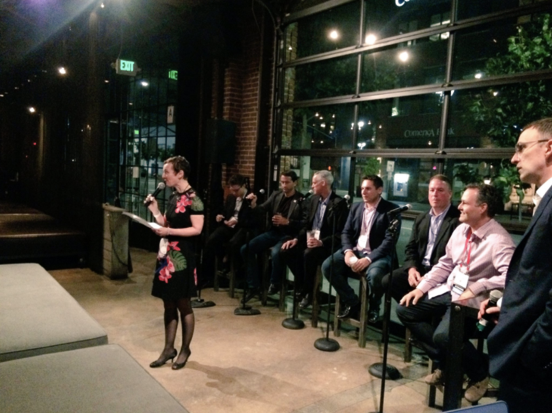What Does “Innovation” Really Mean in Diabetes Technology?
By Jeemin Kwon
By Jeemin Kwon
The diaTribe Foundation’s first “Musings After Hours” discussion with leading experts on digital health and tech in diabetes
At the American Diabetes Association’s 77th Scientific Sessions in San Diego, The diaTribe Foundation hosted our first-ever “Musings Under the Moon: After Hours” – a midnight discussion on digital health. With the “midnight rule” in effect – that is, “no corporate talking points!” – the event offered candid perspectives from bright, innovative leaders in field.
Kelly Close and Jeffrey Brewer, CEO of Bigfoot Biomedical, kicked off the evening and introduced the moderators, Adam Brown, Senior Editor and columnist at diaTribe, and David Lee Strasberg, Creative Director & CEO of the Lee Strasberg Institute. The expert panel included:
-
Lane Desborough – Co-Founder and Chief Engineer, Bigfoot Biomedical
-
Kevin McRaith – CEO, WellDoc
-
Mike Payne – Head of Commercial & Policy, Virta Health
-
Edward Raskin – VP, Public Benefit Development & Corporate Strategy, Beta Bionics
Though the panel covered a wide variety of topics including scalability, cost, and how to harness machine learning, patient experience with diabetes technology was the focus in almost all of the conversations.
An interesting discussion that surfaced several times was “engagement” versus “automation” in diabetes devices. Mr. McRaith (WellDoc) and Mr. Payne (Virta) emphasized the value of engaging users further, making them more aware of their decisions. For instance, Mr. McRaith noted that WellDoc users engage with BlueStar (the type 2 diabetes management app) roughly 24 times per week, and the Virta model, according to Mr. Payne, is to help users change their behavior through better understanding of certain decisions. Meanwhile, the two automated insulin delivery representatives emphasized the importance of minimizing burden. At Bigfoot, Mr. Desborough aims for technology that allows diabetes to “fade into the background” and let the user get on with life. Similarly, Mr. Raskin shared that Beta Bionics actively tries to structure a Bionic Pancreas so that users can “put it away in their pocket and not think about glucose management.” Indeed, as David and Adam indicated from personal experience wearing do-it-yourself systems, hybrid closed loop systems usually work best without constant patient tinkering.
All of the panelists emphasized the need for value-based care (e.g., paid based on outcomes) and delivering long-term metrics that matter over easy short-term wins. Looking forward, the panel agreed that data is what matters – for product development, for convincing insurance companies to pay for devices, and for improving products.
Quotable Quotes
-
“Automated insulin delivery succeeds when it fades into the background and allows you to get on with your life.” – Lane Desborough (Bigfoot Biomedical)
-
“I think engagement may be the wrong metric in digital health – more engagement often means more burden.” – Adam Brown (The diaTribe Foundation)
-
“We want to address the ‘why’ behind decisions…we need to get clinical psychology and endocrinology together.” – Mike Payne (Virta Health)
-
“…folks ignore the fact that these devices are closed down and locked into one kind of insulin or CGM – we need to understand why that happens, what the market forces at play are, and how to stop that because it’s not good for patients.” – Ed Raskin (Beta Bionics)
-
“In my little corner of automated insulin delivery, the most overrated trend is, 'what algorithm is better than the other,' focusing on exactly the wrong problem – algorithms all work, and the real challenge is how to incorporate them into a broader system with pesky humans.” – Lane Desborough (Bigfoot Biomedical)
-
“If we have a discussion, an insurance company needs to have data showing we will increase cost savings. I feel like we’re just at the beginning of digital health, and though the space is just evolving, the insurers are already getting some fatigue because so many digital health companies are coming in. I think the questions now are all about outcomes.” – Kevin McRaith (WellDoc)
-
“There’s no Yelp on digital health, and I wonder how the marketplace will figure out what consumers want as new systems hit the market.” – David Lee Strasberg (Lee Strasberg Institute)
-
“The choices people make to reverse diabetes happen minute-by-minute, not just when you see providers. The first thing we want to do is put a coach and a physician in your pocket 24/7.” – Mike Payne (Virta Health)
-
“I think value-based care is the reason for us that glucagon becomes a reality – that’s how you make the argument that this added cost is worth it.” – Ed Raskin (Beta Bionics)
-
“The scale challenge for automated insulin delivery is complexity, the difficulty is configuring the system so that it’s individualized to where you currently are and where you will be tomorrow when you decide to run a marathon or have a child. It’s a moving target all the time.” – Lane Desborough (Bigfoot Biomedical)
-
“The key thing to remember is diabetes technology is reaching a fraction of the people who can benefit from it. CGM is here and it’s amazing, but an estimated one in seven type 1s use it in the US. An estimated one in three type 1s wear pumps in the US. I think we have a really long way to go, which means we need a ton of options. We need people pushing the envelope with all kinds of novel solutions.” – Adam Brown (The diaTribe Foundation)
-
“I think there’s a learning curve…of all the mistakes I make Looping on a DIY system, it’s just because I won’t let the system do its thing. I always get into trouble…I just don’t tell my wife.” – David Lee Strasberg (Lee Strasberg Institute)







